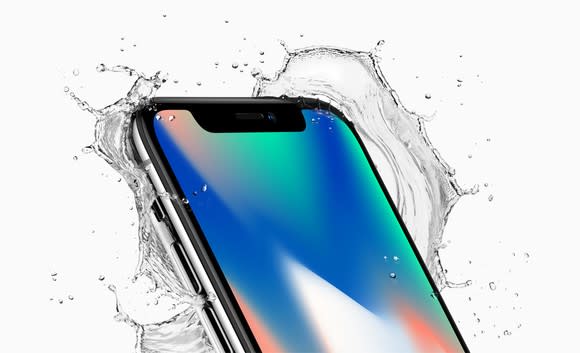Here's Why Many Apple Suppliers' Shares Crashed Last Month
What happened
Shares of several Apple (NASDAQ: AAPL) suppliers fell hard in April of 2018, either in direct response to Cupertino's business results or due to comments made by the iPhone maker's executives.
According to data from S&P; Global Market Intelligence, audio chip supplier Cirrus Logic (NASDAQ: CRUS) fell 10.2% lower in April including a 7% dip in three days as analysts pondered the future of Apple's iPhone plans. Screen builder LG Display (NYSE: LPL) saw a 10.7% month-long dip, and memory chip giant Micron Technology (NASDAQ: MU) took an 11.8% haircut last month. For Apple's own part, its share prices fell 7% in three days but recovered to post a 1.5% total dip for the month -- slightly stronger than the broader market's 2.6% decline.

Image source: Apple.
So what
Before Apple's earnings report at the end of April, it looked like the iPhone X was running into supply chain issues that should put a lid on the sales volume. Build rates calculated by third-party analysts on the back of checks and analysis further down the supply chain indicated that Apple would slash its iPhone X production to about 60% of the expected volume. For example, LG Display and its peers only got 25 million orders for iPhone X-style OLED screens in the first quarter, down from early estimates of roughly 40 million.
Cirrus Logic missed Wall Street's earnings and revenue targets, pinning the blame on lower smartphone volumes than expected. The company is working its way into some Android phones at the moment, but Apple remains its largest smartphone-related client by a long shot, so it's pretty clear that management had expected more iPhone-based orders than they're getting.
In the actual report, Apple avoided publishing any specific unit counts for iPhone X sales but repeated the mantra that the high-priced handset was the best-selling model of all. Investors and analysts walked away from the report with nothing more than a hazy sense of stability.
And in Apple's earnings call with Street analysts, CFO Luca Maestri noted that memory chip prices are running high enough to put pressure on Apple's profit margins right now. A few minutes later, Maestri turned around to a firm prediction that both NAND and DRAM memory prices should peak "very soon," perhaps by the end of 2018. That would be bad news for Micron.
Now what
When mighty Apple moves, it sends ripple effects through the ranks of its suppliers -- and sometimes across entire sub-sectors of the semiconductor and electronics industries, even into corners not directly touched by Apple itself.
I think Cirrus is smart to seek diversification in the Android camp, but it will still take many years to build a significant cushion against Apple-related volatility. LG Display doesn't live or die by Apple's hand alone, having a long history of Android-based business relationships to fall back on while exploring growth in the emerging large-screen OLED TV market.
A couple of analysts took action on Maestri's memory-chip comments, digging into that sector's business trends to confirm the Apple CFO's predictions. They didn't find a whole lot of evidence. For example, Mizuho analyst Vijay Rakesh noted that "actions speak louder than words," and that Apple wouldn't be buying a whole lot of components at peak prices if it expected lower costs later in the year, just as production volumes ramp up in preparation for the holidays.
So Rakesh kept a "buy" rating on Micron, and his price target remains more than 30% above the stock's current prices. I'll admit that Apple's management sits closer to the epicenter of whatever is going on in the various parts of the microchip market, but I'm not selling my Micron shares based on Maestri's comments here.
More From The Motley Fool
Anders Bylund owns shares of Micron Technology. The Motley Fool owns shares of and recommends Apple. The Motley Fool has the following options: long January 2020 $150 calls on Apple and short January 2020 $155 calls on Apple. The Motley Fool also recommends Cirrus Logic. The Motley Fool has a disclosure policy.
